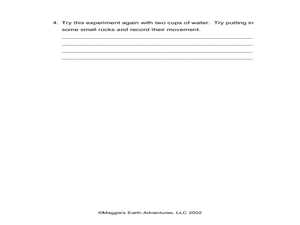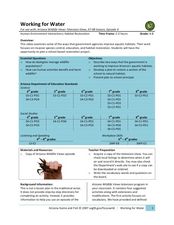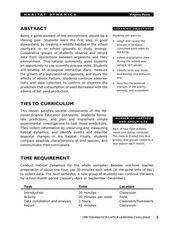Curated OER
Haiku: Observation and Writing in the Japanese Garden
Students observe a Botanical Gardens. Upon returning to the classroom, students write their own Haiku based on their observations.
Curated OER
Treetures
Students identify the different forests of the world and some of the characteristics that differentiate them. They explore old magazines, calendars and photos and fill out a scavenger hunt worksheet.
Curated OER
Wetland Adaptation
Fourth graders study the impact of the wetland environment on the migration of birds. They make a list of the important reasons on a large piece of paper to be posted in the classroom and point out the biggest wetland in the state (The...
Curated OER
Land of No Trees
In this Land of No Trees worksheet, students read a passage titled "Land of No Trees" about the Arctic Tundra and complete an experiment and short answer questions about it. Students complete an experiment with a plastic container, soil,...
Curated OER
A Visit to a North Carolina Museum
Students visit the North Carolina Aquariums website and gather the information requested to complete a worksheet. They use this information to write a story about their imaginary trip.
Curated OER
Autumn: Reading Comprehension
In this reading comprehension worksheet, students read a selection titled "Autumn" and respond to 4 multiple choice questions regarding the selection.
Curated OER
What's in Our Woods?
Young scholars observe their local forest and document the change that occurs over the school year. For this forestry lesson, students utilize a GPS to mark a certain area of the woods as their study area for the remainder of the...
Curated OER
Working for Water
Students examine the ways that government works to help improve aquatic habitats. In this water habitats lesson students view a video and plan a school restoration project.
Curated OER
Is There A Fungus Among Us?
Sixth graders classify fungus into two different groups. In this fungus lesson, 6th graders collect as many pieces of fungus as possible. Students then classify these pieces of fungus as saprophytic or parasitic.
Curated OER
Climate Survival
Pupils use information about different world climate regions to plan how to survive in a particular climate zone for one year. They present their survival plans.
Curated OER
Water Quality and Dissolved Oxygen
Students investigate the relationship between dissolved oxygen and organic materials and aquatic organisms. This is a 3-lesson series in which students explore dissolved oxygen and then design an experiment testing the effects of changes.
Curated OER
Pollution Solutions
Students visit a local park to test the quality of the aquatic environments. They search for sources of pollution and examples of pollution control. Based on their obeservations and experiments, they rate their local environment.
Curated OER
Around the World
Students explore ways people from around the world are like them. They discuss how geography affects the way people live and work and how culture affects a person's day to day life. Students give a presentation over a chosen country to...
Curated OER
Habitat Dynamics
Students develop an interactive diary to record bird seed consumption. In this habitat lesson plan, students predict and record the amount of birdseed eaten each week by birds.
Curated OER
Changing Weather: Comparing Climate from Voyageur Times to Today
Fifth graders compare climates. In this weather lesson, 5th graders observe and record weather observations and discuss the impact of weather on people. Students also discuss the concept of global warming and determine how weather...
Curated OER
Life Cycles
In this life cycles worksheet, students compare the life cycles of 2 different species and answer short answer questions about them. Students can choose the species to compare and then answer 6 questions.
Curated OER
Spring Fling
Students take part in a number of activities that center around a spring theme. They draw the steps to show process of growing seeds.
Curated OER
Geography: Snow Cover on the Continents
Students create maps of snow cover for each continent by conducting Internet research. After estimating the percentage of continental snow cover, they present their findings in letters, brochures or Powerpoint presentations.
Curated OER
Changing How Things Look
Third graders use a literature study in order to investigate how organisms effect an ecosystem. They are asked questions about change taken from the book. Students also take a nature walk to make field observations.
Curated OER
Your Day as a Cycle
Fourth graders investigate several cycles such as life cycles, and the moon cycle. They examine the sequences and patterns that are associated with daily life by keeping a daily journal for three days, and comparing it with others....
Other
Virginia Department of Education: Weather Patterns and Seasonal Changes
By the end of this lesson, students will describe the weather for each season. They will also describe how the weather affects the plants, animals, and people during each season. Activities include taking a weather walk, charting daily...
PBS
Pbs Kids: Hero Elementary: Super Seasons Snapshots
Children can look around to practice making observations and to notice details they might otherwise not notice. There are scenes for each season - spring, summer, fall, and winter. Explore a park to learn how animals and plants change...
Science Struck
Science Struck: Tundra Biome: Info About Its Plants and Animals
Describes the features and characteristics of the tundra biome, the different types, where they are found, their climate and seasonal changes, and their plants and animals.
Annenberg Foundation
Annenberg Learner: Watching the Seasons Change: Fall
This is an appropriate resource for investigating the impact seasonal change has on organisms. Have your students track the changes that come with fall by journaling. The online table addresses physical changes in the environment...






















